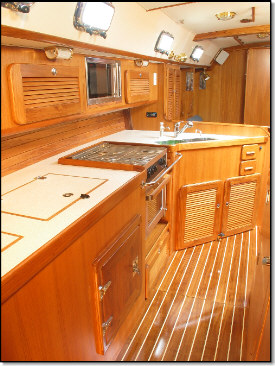The engine room that houses the sea chest lies under the cockpit. Access is via two large doors on the port side and via smaller doors in the aft shower stall. The engine is mounted quite low in the boat and is fitted with an Aqua Drive unit that reduces vibration, wear and noise. The battery bank has been installed on a platform above the engine. Fuel and water filters and all battery switches can be accessed directly via the galley side doors. Caliber takes the trouble to label everything in the engine room and even posts useful reminders of how gear and equipment should be used and maintained.
The boats' electrical systems are designed for maximum self-sufficiency and to carry the load of modern electronics and electrical devices. These days it is common for a cruising couple to expend more than 100 amp/hours a day, and those who navigate with laptops and keep radar on at night will expend 250 to 300 amp/hours every 24 hours. To meet this high demand, the new Calibers come with what they call the Smart Electrical System. The system starts
The primary generating source will be the high output alternator, which has a cold rating of 110 amps and will have a hot rating of something like 60 to 80 amps. For those who want to use engine power
 The galley runs the length of the passageway aft.
The galley runs the length of the passageway aft.